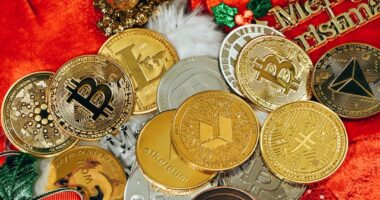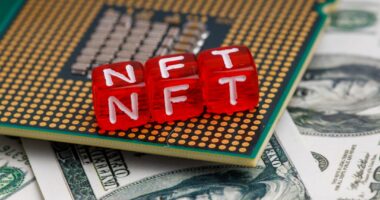NFTs, or non-fungible tokens, have taken the digital world by storm. These unique digital assets have gained significant popularity in recent years, revolutionizing the way we buy, sell, and trade digital content. Unlike cryptocurrencies such as Bitcoin or Ethereum, which are fungible and can be exchanged on a one-to-one basis, NFTs are unique and cannot be replicated.
The process of creating NFTs is known as minting. Minting involves creating a digital asset, attaching it to a blockchain, and verifying its authenticity and ownership. Once an NFT is minted, it can be bought, sold, and traded on various online platforms.
Key Takeaways
- NFTs are unique digital assets that can be bought, sold, and traded on the Ethereum blockchain.
- Ethereum is a decentralized platform that enables the creation of smart contracts and NFTs.
- The latest Ethereum news includes the upcoming Ethereum 2.0 upgrade and the rise of decentralized finance (DeFi) applications.
- To mint an NFT, you need to choose a platform, create your artwork, and follow the specific minting process.
- Tips for successful NFT minting include researching the market, setting a fair price, and promoting your NFT on social media.
Understanding Ethereum and NFTs
Ethereum is the most popular blockchain platform for creating and trading NFTs. It provides a decentralized infrastructure that allows developers to build and deploy smart contracts, which are self-executing contracts with the terms of the agreement directly written into code.
NFTs are created and stored on the Ethereum blockchain using a specific standard called ERC-721. This standard defines the basic functionality and properties of an NFT, such as its unique identifier, ownership information, and metadata.
One of the key benefits of using Ethereum for NFT minting is its robustness and security. The Ethereum network is highly secure and resistant to censorship or tampering. Additionally, Ethereum’s smart contract functionality allows for programmable ownership rights and royalties, ensuring that creators receive compensation for their work even after it has been sold or traded.
Latest Ethereum News and Updates
The Ethereum network is constantly evolving and improving to meet the growing demands of the NFT market. Recent developments include upgrades such as Ethereum 2.0, which aims to improve scalability and reduce transaction fees.
These updates have had a significant impact on NFT minting and trading. With lower transaction fees and faster confirmation times, it has become more accessible for artists and creators to mint and sell their NFTs on the Ethereum network. Additionally, the increased scalability of Ethereum 2.0 allows for a larger number of NFT transactions to be processed simultaneously, reducing congestion on the network.
Looking ahead, Ethereum has ambitious plans for the future of NFTs. The platform is exploring solutions such as layer 2 scaling and interoperability with other blockchains to further enhance the NFT experience. These developments will likely lead to increased adoption and innovation in the NFT space.
Navigating the NFT Mint Radar: A Step-by-Step Guide
Minting NFTs on Ethereum may seem daunting at first, but with the right guidance, it can be a straightforward process. Here is a step-by-step guide to help you navigate the NFT mint radar:
1. Choose the right platform: There are several platforms available for minting NFTs on Ethereum, such as OpenSea, Rarible, and SuperRare. Research each platform to find one that aligns with your needs and goals.
2. Set up a wallet: To mint NFTs on Ethereum, you’ll need a digital wallet that supports Ethereum and ERC-721 tokens. Popular options include MetaMask and Trust Wallet. Set up your wallet and securely store your private keys.
3. Connect your wallet to the platform: Once you have a wallet, connect it to the platform of your choice. This will allow you to interact with the Ethereum blockchain and mint your NFTs.
4. Upload and mint your NFTs: After connecting your wallet, you can upload your digital assets, such as artwork or music files, to the platform. Follow the instructions provided by the platform to mint your NFTs.
Tips for Successful NFT Minting
Before diving into NFT minting, there are several factors to consider to increase your chances of success. Here are some tips to keep in mind:
1. Quality and uniqueness: Ensure that your NFTs are of high quality and offer something unique to the market. Stand out from the crowd by creating original and compelling content.
2. Promotion and marketing: Once you’ve minted your NFTs, don’t forget to promote and market them. Utilize social media platforms, online communities, and influencers to reach a wider audience.
3. Pricing and selling strategies: Set a fair price for your NFTs based on factors such as demand, scarcity, and your reputation as an artist or creator. Consider different selling strategies, such as auctions or limited editions, to create a sense of exclusivity.
Avoiding Common Mistakes in NFT Minting

While minting NFTs can be a rewarding experience, it’s important to avoid common mistakes that can hinder your success. Here are some common mistakes made by NFT minters and how to avoid them:
1. Lack of research: Before minting NFTs, research the market trends, popular platforms, and successful artists or creators. Understanding the market will help you make informed decisions and increase your chances of success.
2. Neglecting quality control: Ensure that your NFTs are of high quality and meet the standards set by the platform you choose. Poorly executed or low-quality NFTs may not attract buyers or collectors.
3. Security and authenticity: Protect your NFTs from theft or fraud by securely storing your private keys and using reputable platforms for minting and trading. Verify the authenticity of the NFTs you purchase to avoid scams or counterfeit assets.
Maximizing Your NFT Minting Potential
To maximize your potential in the competitive NFT market, consider implementing the following strategies:
1. Build a strong brand: Establish a unique brand identity that resonates with your target audience. Consistency in your artwork, messaging, and overall aesthetic will help you stand out and attract loyal collectors.
2. Community engagement: Engage with your audience and build a community around your NFTs. Interact with collectors, respond to comments and feedback, and offer exclusive perks or rewards to your most dedicated supporters.
3. Collaborate with others: Collaborating with other artists or creators can expand your reach and introduce you to new audiences. Consider partnerships, joint releases, or cross-promotions to mutually benefit from each other’s networks.
NFT News: Trends and Developments
The NFT market is constantly evolving, and staying up to date with the latest trends and developments is crucial. Here are some recent trends and developments in the NFT space:
1. Celebrity endorsements: The endorsement of NFTs by celebrities and influencers has brought mainstream attention to the market. High-profile individuals such as musicians, athletes, and actors have started minting and selling their own NFTs, attracting a wider audience.
2. Mainstream adoption: NFTs are no longer limited to the art world. They are being adopted by various industries, including gaming, music, fashion, and real estate. This diversification of use cases is driving increased interest and investment in the NFT market.
3. Future predictions: Experts predict that NFTs have the potential to disrupt traditional industries such as finance, licensing, and intellectual property rights. The ability to tokenize real-world assets opens up new possibilities for fractional ownership and decentralized marketplaces.
The Future of NFTs and Ethereum
The future of NFTs and Ethereum is filled with potential and opportunities. Here are some potential use cases for NFTs beyond art and collectibles:
1. Gaming: NFTs can be used to tokenize in-game assets, allowing players to buy, sell, and trade virtual items securely and transparently. This opens up new revenue streams for game developers and enhances the gaming experience for players.
2. Real estate: NFTs can be used to tokenize real estate properties, making it easier to buy, sell, and invest in real estate assets. Fractional ownership of properties can be achieved through NFTs, allowing for increased liquidity and accessibility.
3. Intellectual property rights: NFTs can be used to establish ownership and manage intellectual property rights for digital content such as music, videos, and written works. This ensures that creators are properly compensated for their work and have control over its distribution.
However, there are also challenges that need to be addressed for the future of NFTs and Ethereum. These include scalability issues, environmental concerns related to energy consumption, and the need for improved user experience and accessibility.
Navigating the NFT Mint Radar with Confidence
In conclusion, NFT minting on Ethereum offers exciting opportunities for artists, creators, and investors alike. By understanding the basics of NFTs, navigating the Ethereum network, and implementing best practices, you can confidently explore the world of NFT minting and trading.
As the NFT market continues to evolve and mature, it is important to stay informed about the latest trends, developments, and potential use cases. With careful research, strategic planning, and a commitment to quality and authenticity, you can maximize your potential in the NFT space.
The future of NFTs and Ethereum holds immense potential to revolutionize various industries and reshape the way we buy, sell, and trade digital assets. By embracing this technology with confidence and creativity, you can be at the forefront of this digital revolution.
If you’re interested in learning more about the world of NFTs and want to dive deeper into the topic of successful NFT minting, you should definitely check out this informative article on ETH News titled “Hello World: A Beginner’s Guide to NFTs.” This article provides a comprehensive introduction to NFTs, explaining what they are and how they work. It also offers valuable tips and insights for those looking to navigate the NFT minting process successfully. So, if you’re ready to embark on your NFT journey, click here to read the article and gain a solid foundation in this exciting digital asset space.
FAQs
What are NFTs?
NFTs or Non-Fungible Tokens are unique digital assets that are stored on a blockchain. They are used to represent ownership of digital content such as art, music, videos, and other forms of creative work.
What is NFT Minting?
NFT Minting is the process of creating and issuing new NFTs. It involves uploading digital content to a blockchain and creating a unique token that represents ownership of that content.
What is the NFT Mint Radar?
The NFT Mint Radar is a tool that helps NFT creators and collectors discover new NFT minting projects. It provides information on upcoming NFT drops, including the date, time, and platform where they will be available.
What are some tips for successful NFT Minting?
Some tips for successful NFT Minting include researching the project and the platform where it will be minted, creating high-quality digital content, setting a reasonable price, and promoting the NFT through social media and other channels.
What are some popular platforms for NFT Minting?
Some popular platforms for NFT Minting include OpenSea, Rarible, SuperRare, and Nifty Gateway. Each platform has its own unique features and benefits, so it’s important to research and choose the one that best fits your needs.





